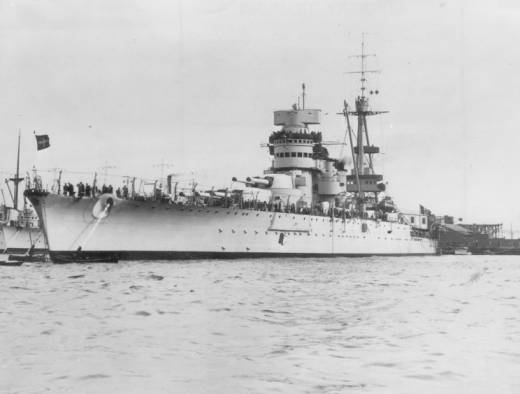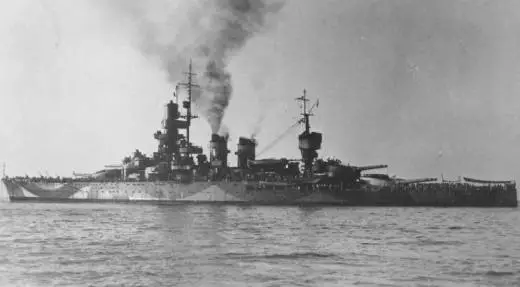Italy and the Washington Naval Treaty
According to the Washington naval treaty, signed in 1922, Italy was allowed to retain 175.000 tons of capital ships, the same amount granted to the French Navy. At the time, the Regia Marina could count on five dreadnoughts (Dante Alighieri, Cavour, Cesare, Duilio, Andrea Doria) and four pre-dreadnought battleships (Regina Elena class). There was also the hull of the Leonardo Da Vinci, recovered after the explosion that sunk it in the waters of Taranto.
The treaty prohibited the construction of new battleships by the five signatory powers until 1931, the so-called “battleship vacancy”. France and Italy were allowed to build new battleships already from 1927 and 1929, due to the lower military value of their existing capital ships.
The vacancy was very well received by a financially stressed Italy, struggling also on the social and political level. For the rest of the 1920s, new naval constructions focussed only on light vessels and, from 1925 the construction of new cruisers started.
Only in 1929, a debate sparked in the Regia Marina on what to do with the surviving dreadnoughts. The Dante Alighieri was decommissioned and scrapped in 1928, Cavour was disarmed and the Cesare transformed into a training ship. At this time, the prevailing idea among the higher ranks of the Navy was to decommission and scrap all the surviving dreadnoughts. However, it was also believed that Italy should have not commenced any race for new battleship constructions, thus the fate of the old dreadnoughts remained uncertain.
The reconstruction of Giulio Cesare and Conte di Cavour
In 1930, the London Naval treaty, extended the battleship vacancy until 1936, an extension positively welcome by many. In 1932 the French laid down the battleship Dunkerque, a direct response to the construction of the first Deutschland class pocket battleship in Germany (1931).
In 1932 the Regia Marina’s committee of admirals met to evaluate the response to Dunkerque. Four ideas were put forward:
Plans for a 29,500-ton battleship, plans for a 26,000-ton battleship, plans for a 20,000-ton battleship (similar to the Deutschland class) and finally a modernization project of the Cavour class. Until then, the reconstruction or modernization of the old units had never been considered, mainly because their underwater protection was considered insufficient.

Battleship Giulio Cesare
The Naval engineer Col. Francesco Rotundi worked out the modernization plan for old battleships. The new configuration envisaged a displacement of 23,700 tons, a small increase in length due to a new bow. The artillery would have decreased from 13 to 10 guns with increased calibre (320 mm). Secondary armament consisted of 12×120 mm guns in 6 twin turrets, 8×100 mm guns in 4 twin turrets for AA defence, complemented by smaller guns. After some more thinking, the reconstruction plan was approved and works started in October 1933, the Cavour in Trieste and the Cesare in Genova. For the time being, the two Duilios were not considered for the reconstruction.
A new escalation
The decision to rebuild the Cavour class must be put in the context of the early 1930s. Negotiations for the new naval treaty were three years away and the future of battleships in the new naval treaty was still uncertain. Within the limits of the previous agreements, the reconstruction of Cesare and Cavour was considered an adequate response to the Dunkerque and a stop-gap solution for the time being. At the end of 1933, talks took place between the French and the Italians, trying to agree on limitations for the future naval constructions until 1936. However, the talks derailed in March 1934 when France decided to lay down the second Dunkerque class battleship in response to the fourth Deutschland class battleship laid down by Germany.
In direct response, Italy reacted by laying down two brand new battleship of 35.000 tons (the limit prescribed by the treaty), armed with 381mm guns, the Littorio class. The decision was pushed forward by Admiral Domenico Cavagnari, commander in chief and State secretary for the navy (de facto Minister), a powerful figure who merged the political and military leadership of the Regia Marina. Cavagnari still believed in the battleship as the central and most important vessel in the navy, he convinced a reluctant Mussolini to make the effort of building the new units, putting under stress the already limited budget. In response, the French laid down their 35.000 tons ships, the Richelieu and Jean Bart.
With the end of the battleship vacancy approaching, talks for the new naval treaty started in 1935. However, the talks failed for several reasons, including the deteriorating international situation. This failure put an end to naval disarmament and re-opened the race for new constructions.
The reconstruction of Caio Duilio and Andrea Doria

Andrea Doria Battleship
At the end of 1935, the Regia Marina started to consider and study the reconstruction of the two Duilios. The final decision on their reconstruction was taken in 1937, and the two ships entered the shipyards soon after the works on the two Cavour had ended. This decision still puzzles historians today and does not have a clear explanation. As mentioned before, the decision to rebuild the Cavour and Cesare was a stop-gap solution in a period of uncertainty for the construction of capital ships. However, the situation had radically changed in 1937, the naval race had started once again, and all new foreign constructions would have been superior to the rebuilt Duilios. Additionally, the economic sanctions against Italy by the League of Nations (following the invasion of Ethiopia) worsen the ability of the country to retrieve the raw materials necessary to complete two Littorio class battleships and to rebuild the Duilios. On the contrary, not re-building the Duilios could have meant a faster completion of the two Littorios or perhaps the earlier completion of the Roma (laid down in 1938). Perhaps the Regia Marina believed that it could quickly set up a homogeneous division of four modernized battleships at a relatively low cost.
On a technical level, the rebuilt Duilio class was better armed than the rebuilt Cavour class, they could count on a more modern and effective secondary and AA armament. The two ships re-entered service in 1940 when Italy had already entered the second world war. The events of 1940-1943 demonstrated that the decision to rebuild these last two dreadnoughts did not pay off, they played a secondary role in the conflict and the resources committed in their reconstruction could have been diverted to destroyers or the earlier completion of a third Littorio class battleship.
Sources
Bagnasco, E., & De Toro, A. (2008). Le corazzate delle classi “Conte di Cavour” e “Duilio” (1911-1956). Edizioni Storia Militare.
Bagnasco, E., & De Toro, A. (2020). Le navi da battaglia classe “Littorio” 1937-1948. Roma: Ufficio storico della Marina Militare.
Giorgernini, G. (2001). La Guerra Italiana sul mare, La marina tra vittoria e sconfitta 1940-1943.